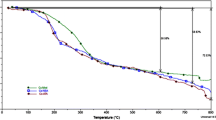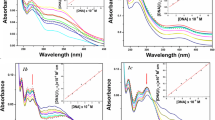Abstract
The mixed ligand complexes MLA of Cu(II) and Co(II) with Schiff base derived from 4-amino antipyrine and 5-NO2 salicylaldehyde (2,3 –dimethyl-1-phenyl-4-(2-hydroxy-5-nitro benzylideneamino)-pyrazol-5-one) as ONO donor (L) and A = 2,2 bipyridine (bpy),1,10 phenonthroline (1,10 phen) as N, N donor ligands have been prepared, owing to their biological and other applications. The structural features have arrived from their elemental analyses, magnetic susceptibility, molar conductance, Mass, IR, UV–VIS, powdered XRD and ESR spectral studies, that established MLA type of composition for the metal complexes. The electronic absorption spectral data of the complexes suggest an octahedral geometry around the central metal ion. The interaction of the complexes with Calf Thymus (CT) DNA has been studied using absorption spectra, viscosity measurements and fluorescence spectra. The binding constants (Kb) of the complexes were determined as 2.1 × 106 M−1 for complex 1, 2.5x106M−1 for complex 2, 1.16 × 106 M−1 for complex 3,1.25x106M−1 for complex 4, DNA cleavage experiments performed on pBR-322 plasmids using metal complexes in the presence of H2O2 showed that all the complexes afford a pronounced DNA cleavage. Molecular modelling studies were also performed to confirm the geometries of the complexes. The ligand and their metal complexes were screened for their antimicrobial activity against bacteria. The results showed that the metal complexes are biologically active.












Similar content being viewed by others
References
Sondi SM, Sharma VK, Verma RP, Singhal N, Shukla R, Raghubir R, Dubey MP (1999) Synthesis, anti inflammatory and analegesic activity evalution of some mercapto pyrimidine and pyrimidobenzimidazole derivatives. Synthesis 5(131):878–884
Hardcastle SA, Dieppe P, Gregson CL, Hunter D, Thomas GER, Arden NK, Spector TD, Hart DJ, Laugharne MJGA, Clague GA (2014) Prevalence of radiographic hip osteoarthritis is increased in high bone mass. Osteoarthr Cartil 22(8):1120–1128
Koo HJ, Yoon WJ, Sohn EH, Ham YM, Jang SA, Kwon JE, Jeong YJ (2014) The analgesic and anti-inflammatory effects of Litsea japonica fruit are mediated via suppression of NF-κB and JNK/p38 MAPK activation. Int Immunopharmacol 22:84–97
Sampath K, Raja G, Butcher RJ, Jayabalakrishnan C (2013) DNA binding/cleavage, antioxidant and cytotoxic activities of water soluble cobalt(II) and copper(II) antipyrine complexes. Inorganica Chimica Act 406:44–52
Ito T, Goto C, Noguchi K (2001) Lanthanoid ion-selective solvent polymeric membrane electrode based on 1-phenyl-3-methyl-4-octadecanoyl-5-pyrazolone. Anal Chim Acta 443:41–51
Sondhi SM, Singhal N, Verma RP, Arora SK, Dastdar SG (2001) Synthsis hemin and porphyrin derivatives and their evalution for anti cancer activity. Indian J Chem b 40:113–119
Bao F, Lu X, Kang B, Wu Q (2006) Vinyl polymerization of norbornene catalyzed by a series of bis(b-ketoiminato)nickel (II) complexes in the presence of methylaluminoxane. Eur Polym J 42:928–934
Hurley LH (2002) Nat.Rev.2 188
Shanker K, Rohini R, Shravan kumar K, Muralidhar Reddy P, Ho YP, Ravinder (2009) Ru(II) complexes of N4and N2O2 macrocyclic Schiff base ligands, their antibacterial and antifungal studies. Spectrochim Acta A Mol Biomol Spectrosc 73(1):205–211
Raman N, Sobha S, Mitu L (2013) Design, synthesis, DNA binding ability, chemical nuclease activity and antimicrobial evaluation of Cu(II), Co(II), Ni(II) and Zn(II) metal complexes containing tridentate Schiff base. J Saudi Chem Soc 17:151–159
Sathiyaraj S, Sampath K, Raja G, Butcher RJ, Gupta SK, Jayabalakrishnan C (2013) DNA binding/cleavage, antioxidant and cytotoxic activities of water a soluble cobalt(II) and copper(II) antipyrine complexes. Inorg Chim Acta 406:44–52
Anupama B, Sunitha M, Kumari C, Gyana (2011) Synthesis, characterization, DNA binding and antimicrobial activity of copper (II) complexes with 4-aminoantipyrine schiff bases. Asian J Res Chem 4(10):1529–1535
Reichmann MF, Rice SA, Thomas CA, Doty P (1954) A further examination of the molecular weight an size of desoxypentose nucleic acid. J Am Chem Soc 76:3047–3053
Dixit N, Koiri RK, Maurya BK, Trigun SK, Hobartner C, Mishra L (2011) One pot synthesis of Cu(II) 2,2-bipyridyl complexes of 5-hydroxy-hydurilic acid and alloxanic acid: synthesis, crystal structure, chemical nuclease activity and cytotoxicity. J Inorg Biochem 105:256–267
Lakowicz JR, Webber G (1973) Quenching of fluorescence by oxygen probe for structural fluctuations in macromolecules. Biochemistry 12:4161–4170
Waheb ZH, Mashalay MM, Fahem AA (2005) Chem Pap 59:25
Alemi AA, Shaabani B (2000) Synthesis and characterizationof a p-tert-Butylcalix [4] arene and its complex with copper (II). Acta Chim Solv 47:363–369
Makode JT, Aswar AS (2004) Synthesis, characterization, biological and thermal properties of some new Schiff base complexes derived from 2-hydroxy-5-chloroacetophenone and S-methyldithiocarbazate. Indian J Chem A43(10):2120–2125
Naik VM, Mallur NB (2002) Synthesis and characterization of niobium(V) complexes with terdentate ONO donor hydrazones. Indian J Chem Sect A 41:780–784
Nakamoto K (1997) Infrared and raman spectra of inorganic and coordination compounds, 3rd edn. Wiley, New York
Rabindra Reddy P, Shilpa A, Raju N, Raghavaiah P (2011) Synthesis,structure, DNA binding and cleavage properties of ternary amino acidSchiff base-phen/bipy Cu(II) complexes. J Inorg Bio Chem 105:1603–1612
Yang L, La CA, Anderson OP, Crans DC (2002) 4-Hydroxypyridine-2,6-dicarboxylatodioxovanadate(V) complexes. Solid State Aqueous Chem Inorg Chem 41:6322–6331
Lever ABP (1971) Inorganic electronic spectroscopy, New York
Dunn TM (1960) The visible and ultraviolet spectra of complex compounds in moderm coordination chemistry interscience, New York
Rabindra Reddy P, Shilpa A (2011) Oxidative and hydrolytic DNA cleavage by Cu(II) complexes of salicylidene tyrosine schiff base and 1,10 phenanthroline/bipyridine. Polyhedron 30:565
Raman N, Kulandaisamy A, Jeyasubramanian K (2002) Synthesis,spectral,redox,and anti microbial activity of Schiff base transition metal(II)complexes derived from 4-aminoantipyrine and benzyl. Syn React Inorg Metal Org Nano Metal Chem 32:1583–1610
Raman N, Kulandaisamy A, Shanmugasundaram A (2001) Synthesis, spectral, redox and antimicrobial activities of Schiff base complexes derived from 1-phenyl-2,3-dimethyl-4-aminopyrazol-5-one and acetoacetanilide. Trans Met Chem 26:131–135
Nikolaev AV, Myachina LI, Logvinenko VA (1969) Therm Anal 2:779
Daniels T (1973) Thermal analysis. Wiley, New York
Freeman ES, Carroll BJ (1958) Phys Chem 62:39
Mishra AP, Khare M (2000) Non-isothermal degradation and kinetic parameters of some Schiff base complexes. J Indian Chem Soc 77:367–370
Choi SN, Menzel ER, Wasson JR (1977) Electronic spectra of copper(II) dithiocarbamates. J Inorg Nucl Chem 39:417
Kumar DN, Singh BK, Garg BS, Singh PK (2003) Spectral studies on copper(II) complexes of biologically active glutathione. Spec Chim Acta 59:1487–1496
Hathway BJ, Bardley GN, Gillard RD (1971) Eds, Essays in Chemistry Academic press Newyork, USA
Suresh Babu V, Ramesh A, Raghuram P and Raghava Naidu R(1997) Electron spin resonance studies on complexes of Copper(II) with o-phenolic oximes. Polyhedron1(7–8):607–610
Dhanaraj CJ, Nair MS (2009) Synthesis, characterization, and antimicrobial studies of some Schiff-base metal(II) complexes. J Coord Chem 62:4018–4028
Peng B, Chao H, Sun B, Li H, Gao F, Ji LN (2007) Synthesis, DNA-binding and photocleavage studies of cobalt(III) mixed-polypyridyl complexes: [Co(phen)2(dpta)]3+ and [Co(phen)2(amtp)]3+. J Inorg Biochem 101:404–411
Uma V, Kanthimathi M, Weyhermuller T, Nair BU (2005) Oxidative DNA cleavage mediated by a new copper(II) terpyridine complex: Crystal structure and DNA binding studies. J Inorg Biochem 99:2299–2307
Kumar CV, Asuncion EH (1993) DNA binding studies and site selective fluorescence sensitization of an anthryl probe. J Am Chem Soc 115:8547–8553
Kumar LS, Revanaslddappa HD (2011) Synthesis, characterization, antimicrobial, DNA binding, and oxidative cleavage activities of Cu(II) and Co(II) complexes with 2-(2-hydroxybenzylideneamino)isoindoline-1,3-dione. J Coord Chem 64:699–714
Wolfe A, Shimer GH, Meehan T (1987) Polycyclic aromatic hydrocarbons physically intercalate into duplex regions of denatured DNA. BioChem 26:6392
Fahmi N, Gupta IJ, Singh RV (1998) Sulfur bonded palladium(II)and platinum(II) complexes of biologically potent thioamides. Phos Sulfur Silicon 132:1–8
Chaudhary A, Singh RV (2003) Studies on biologically potent tetraazamacrocylic complexes of bivalent tin.Phos Sulfur. Silicon 178:615–626
Arguslab 4.0 Marky Thomson, Planaria software IC, Seattle, WA; www.arguslab.com/
Thompson MA, Zerner MC (1991) A theoretical examination of the electronic structure and spectroscopy of the photosynthetic reaction center from Rhodopseudomonas viridis. J Am Chem Soc 113:8210–8215
Thompson MA, Eric DG, Feller D (1996) J Phys Chem 98:10465
Acknowledgments
We thank to University grants commission (UGC, NEW Delhi, India) for financial support in the form of junior research fellow to me. We thank to HCU for extending the ESR facility and Department of Bio chemistry (Osmania University, Hyderabad) for microbial activity.
Author information
Authors and Affiliations
Corresponding author
Rights and permissions
About this article
Cite this article
leela, D.S., Ushaiah, B., Anupama, G. et al. Synthesis, Characterization, Antimicrobial, DNA Binding and Cleavage Studies of Mixed Ligand Cu(II), Co(II) Complexes. J Fluoresc 25, 185–197 (2015). https://doi.org/10.1007/s10895-014-1496-7
Received:
Accepted:
Published:
Issue Date:
DOI: https://doi.org/10.1007/s10895-014-1496-7




